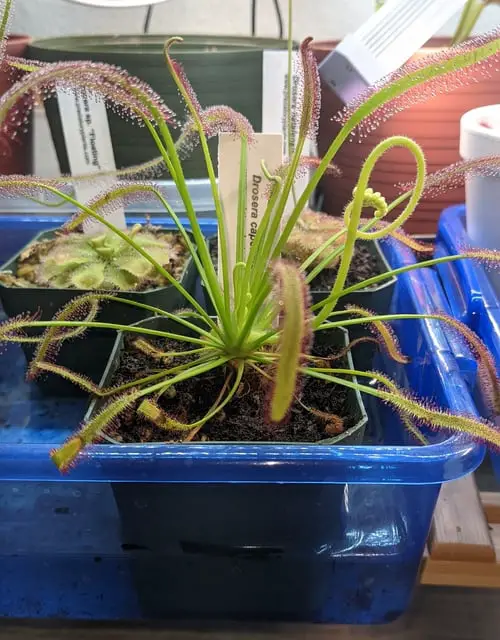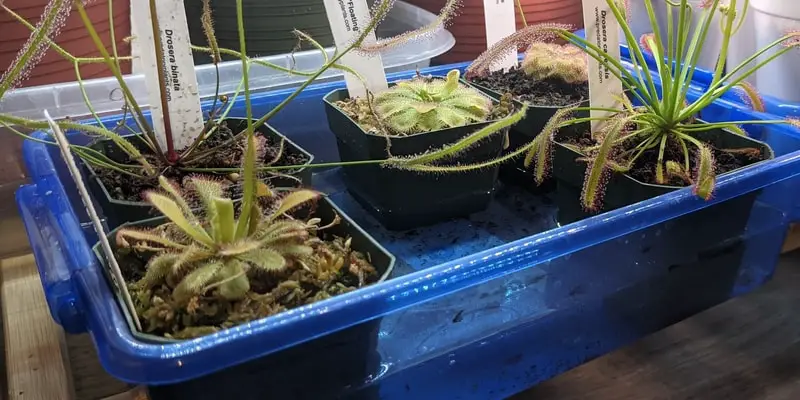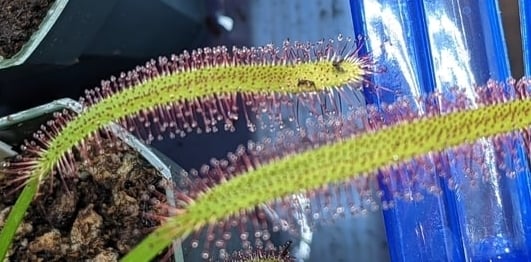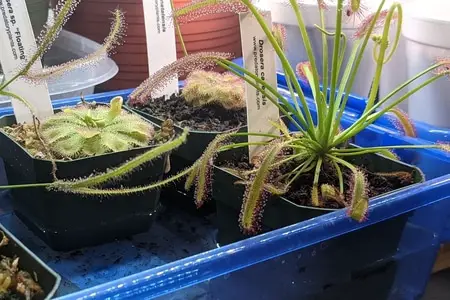I have grown carnivorous plants in my home for several years, but only last year I got my first Drosera plants. One of the first things that I had to master to care for my new plants was the watering process. In this article, I share a method to water Drosera at the optimal level.
As a general rule, Sundews should be watered with pure water and kept in humid to damped soil. They must be kept in trays filled with water up to one-half of the height of the plant’s pot. Pure water includes distilled water, reverse osmosis water, and rainwater.
Sundew plants are beautiful, with their colorful leaves and mesmerizing shapes. Even though they seem delicate, they are not hard to keep alive. This article will teach you exactly how to water your Sundew to keep it healthy.
How to Water Sundews (Complete Instructions)
Before you attempt to water a Sundew, you must get the correct water. This is of crucial importance as the incorrect water can kill them.
Sundews are carnivorous plants, and therefore are intolerant to the minerals present in most water. So, what water is safe for Sundews.
Distilled water, reverse osmosis water, and rainwater is safe for Sundews. Never water Sundews with tap water or bottled water, as these contain large amounts of minerals that are very harmful to them.
If you are unfamiliar with how to make or where to get distilled water, reverse osmosis water, or rainwater, read the next section to get all the details.
Now, I will explain the specifics of how to water Sundews.
When watering Sundews, you have two options: water them from the top or bottom. Watering from the tops means pouring water directly into the soil, while watering from the bottom means adding water to the plant’s water tray.
Sundews prefer to be watered from the bottom by employing the tray method. Watering from the top is not harmful to Sundews, but it tends to slow down their growth, as the water can wash away the plant’s dew drops.

Here are the instructions of how you should water a Sundew with the tray method:
- Get pure water for your Sundew.
- Grab a tray or container that can act as a tray for your plant
- Place your Sundew in the tray
- Add water directly to the tray until you reach one-half of the height of your plant’s pot.
- Then, as the water level lowers over time water again to keep it at the initial level.
Here is a picture of some of my Sundews growing in their trays with water. Watering from the bottom keeps them healthy and saves me time, as I do not have to water constantly. I fill the tray, and the water lasts for several days. Once it lowes from 1/2 to 1/3 of the height of the pot, I refill.

If you decide to water your Sundew from the top, try not to splash water on top of the leaves and make sure you water often enough to keep the plant healthy.
How much water do Sundews need?
The amount of water you employ for Sundew will vary through the seasons and depending on the size of your plant. Still, you can follow this general rule:
Sundews need to be watered often to keep the soil constantly wet. They thrive in damped, water-logged conditions. Water Sundews often by employing the tray method and keeping the tray with water at all times.
Many people hesitate about growing their Sundews sitting in water because most plants suffer in water-logged conditions. However, Sundews thrive in such environments.
It is safe to let Sundews sit in water. GrowingDrosera in a tray filled with water is a common and effective practice that allows growers to keep a high moisture level in the soil. The water in the tray also assists by providing high humidity levels.
Now, let’s explore more details about the specific water to employ with Sundews.
What Water is Safe for Sundews
Most people water their plants with Tap water, which is safe for most plants. However, carnivorous plants are a bit tricky in this aspect.
Sundews require water with low to no mineral content. Preferably, they must be watered with pure water sources that do not contain minerals, electrolytes, or any additives.
Distilled water, reverse osmosis water, and rainwater are the safest options for Sundews.
Some tap water or bottled water can be safe for Sundews; however, this is not always the case. Unless you plan on testing the composition of the water, I recommend sticking to pure water.
Where To Get Water for Your Sundew
I grow carnivorous plants, so I know the struggle of always having to look for special water for my plants. But, don’t worry, I have simplified the process.
Distilled water: You can buy distilled water at the grocery store. I buy a distilled water jug every few weeks for less than a dollar, and it is all I need. For your reference, here is a picture of the distilled water I buy.

You can also make distilled water at home. I explain the complete process in this article: Easy Method to Make Distilled Water.
Rainwater: Rainwater is fairly easy to collect in many places. If you live in a rainy location, consider a rain collection system.
Reverse osmosis: RO water is a bit harder to get but is sometimes available in water stores or at home if you have an RO system installed.
A Practical Alternative:
Filtered water is usually unsuitable for carnivorous plants, as most filters do not eliminate the minerals we want to avoid. However, there is one water filter product that fulfills the requirements of sundews.
ZeroWater water filters work well for carnivorous plants. It is the only water filter (that I am aware of) that filters dissolved solids. With ZeroWater, you can reduce the part per million (ppm) from tap water to bottled water to ZERO.
With ZeroWater, you can filter tap water or bottled water and use the filtered water for your Sundews!
Tips for Watering Sundews
Here are tips to make sure your sundew remains healthy with the watering you provide
- Never let the soil of your Sundew dry out. A dried-up soil can kill Sundews very quickly.
- Research if your specific Sundew undergoes dormancy. During dormancy, you should reduce the watering frequency slightly to keep the soil humid but not damp.
- If you water your plant from the top, avoid pouring water on the leaves, as this practice reduces the stickiness of the leaves.
- Instead of misting, consider buying a humidifier.
- Consider adding perlite or sand to the growing medium of your plant to promote aeration.
- The presence of dewdrops in your Sundew is a sign of good growing conditions.

Sundews and Their Humidity Requirements
Most Sundew prefer high humidity environments. Even though they can survive in dry climates, humid environments are optimal to grow large and colorful sundews with lots of dew.
Humidity greater than 40% is optimal for Sundews. High humidity helps the Sundew produce dew-drops and promotes new growth. In dry climates, it is recommended to employ alternative methods to increase humidity levels.
You can increase the relative humidity around your plant by using the water tray method, misting your plant, employing a humidifier, or a terrarium.
The water tray method is effective for watering and for increasing the humidity near your plant.
Misting is not an effective as the other methods, it only increases the humidity momentarily, and it can cause your plant to lose some dew.
Humidifiers are an effective alternative to increase humidity. For best results, run the humidifier consistently every day. Also, you need to employ a product that is powerful enough to produce a meaningful change where your plants live. For example, a small humidifier will provide almost no benefit outdoors or in a very large room.
Terrariums are often used for tropical plants and they can be beneficial for Sundews.
Terrariums can live in terrariums. Close terrariums increase humidity substantially, while open terrariums or tanks provide minimal changes. Consider employing a greenhouse terrarium to store your Sundews.
Keep in mind that terrariums made up of glass can heat up tremendously when placed under direct sunlight.
Sundew Care Guide
Not all Drosera species require the exact same care considerations. However, most will thrive on the same general conditions. This section contains a guide on how to generally care for a Sundew to keep it alive and healthy.
Soil: Employ nutrient-free and fertilizer-free carnivorous plant soil. You can use a mixture of peat moss or sphagnum moss with perlite or silica sand. The perlite or sand is not required, but it can be beneficial for your plant. Here is a link to high-quality carnivorous plant soil you can buy online.
Lighting: Sundews thrive in sunny conditions. You can employ artificial or natural light to fulfill this requirement. Provide a minimum of 6 hours of light exposure every day. And optimally expose to more than 12 of light. If you plan to employ artificial lighting, here are a few lights I have used for my Sundews:
- Small plant light for 1-4 plants: https://amzn.to/2RsGlxr
- T8 LED light fixture for multiple plants (6500k Cool White): https://amzn.to/3uWoeh2
Watering needs: Employ the water tray method to keep the soil wet throughout the year. Only use ro water, distilled water, or rainwater for your plant.
Feeding: Let outdoor plants capture their own bugs. Indoor plants might require your help getting food. Use live bugs or rehydrated dead bugs to feed your plant every 2-4 weeks.
Trimming: Sundews produce dried-up leaves every once in a while. Please wait until the leaf has withered entirely and use sharp scissors to trim them when necessary.
Humidity needs: Keep humidity levels between 40% and 70%. A humidifier is a practical solution to increase the humidity indoors.
Use of Fertilizers: Avoid fertilizing Sundews to prevent damage. Fertilizers build up in the soil and can produce mineral burns and kill the plant.
Dormancy: Some sundews require dormancy, which is a period of inactivity. Please find out the dormancy needs of your specific Sundew to keep it healthy.
Repotting: Avoid repotting your Sundew unless it is strictly necessary. Most Sundews can stay in the same pot for several years.
I hope you found this guide to be useful! Here are a few more resources which can be useful for you:


